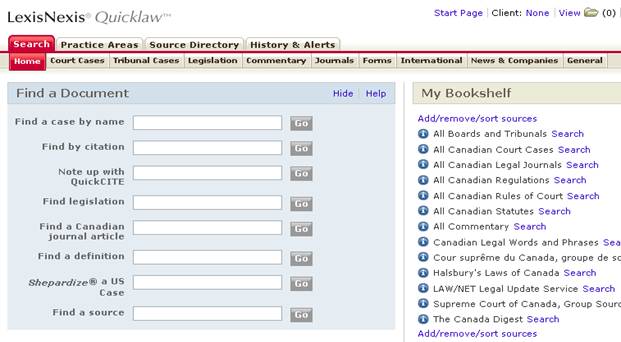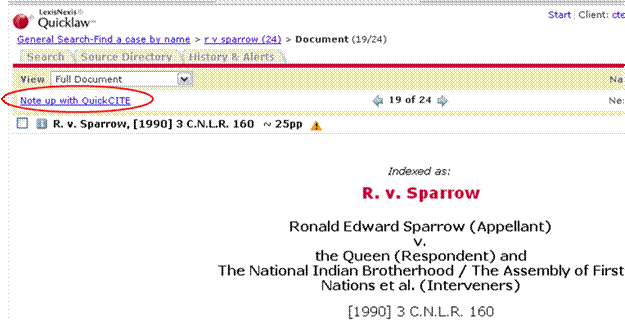Case Law and the Canadian Abridgement – Noting-Up Electronically with QuickCITE
QuickCITE is a function in LexisNexis/QuickLaw that gives you three different ways to access the history of a case and to note-up.
"Note up with QuickCITE" search box on the home page

"Note up with QuickCITE" link while viewing a case

QuickCITE Case Treatment Symbols
It is necessary to understand the unique symbols LexisNexis/Quicklaw uses to identify case treatments:
Citator Information Icon
The case has no known history or treatments.
Positive Treatment Icon
The case has positive history (affirmed, judicial review denied, or leave to appeal refused by a higher court) or positive treatments (followed or followed in a minority opinion of a subsequent court).
Cautionary Treatment Icon
The case has been distinguished by a subsequent court.
Negative Treatment Icon
The case has negative history (judicial review allowed, reconsideration allowed, reversed, quashed, or varied by a higher court) or negative treatments (not followed or questioned by a subsequent court).
Neutral History or Treatment Icon
The case has neutral treatments (mentioned, explained, or cited in a dissenting opinion) or the case has history (abandoned, abated, leave to appeal granted, reconsideration denied, related proceeding, same case, or supplementary reasons by a subsequent court), but the citing court does not comment on the case.
(from www.lexisnexis.com)
The following terms are used to indicate what sort of judicial treatment a case has received from subsequent citing cases:
Distinguished - The cited case is held to be inapplicable because of a difference in fact or law.
Explained - The citing case adds to, expands upon or interprets the cited case. The cited case is not decisive but it is given some kind of consideration.
Followed - The citing case in a majority or plurality opinion applies a principle of law from the cited case. The judge expressly relies on the cited case as a precedent on which to base a decision.
Followed in minority - The citing case, in an opinion other than a majority, plurality, or dissent applies a principle of law from the cited case.
Dissenting (cited in) - The case is cited in a dissenting opinion dissent. opinion) within the citing case.
Mentioned - The case is cited with no explicit treatment. The citing case provides no more information about the cited case than what was available in the cited case itself.
Not followed - The citing case overrules or refuses to apply the cited case for some reason other than it was distinguishable.
Questioned - The citing case criticizes the conclusion or reasoning of the cited case, without refusing to follow it. Alternatively, legislation in force at the time the cited case was decided has been amended to the extent that the cited case might have been decided differently under the amended legislation.
(from www.lexisnexis.com)
QuickLaw utilizes the following terms to describe history relationships:
Abandoned - The appeal is withdrawn by one of the parties, or both, or by the court for failure to actively pursue the appeal.
Abated - The issue has become moot, for example when one of the parties dies.
Affirmed - The appeal is dismissed, whether or not the decision of the court below is expressly affirmed.
Jud. Review Allowed - The Court grants an application for relief from an administrative decision.
Jud. Review Denied - The Court refuses an application for relief from an administrative decision.
Leave Granted - The citing decision allows leave to appeal.
Leave Refused - The citing decision refuses leave to appeal.
Quashed - The lower court decision is set aside on the basis that the lower court had no jurisdiction to decide the matter before it.
Reconsid. Allowed - The court or board grants a request to amend or reverse its original decision.
Reconsid. Denied - The court or board refuses a request to amend or reverse its original decision.
Related Proceeding - The citing decision refers to an earlier proceeding arising out of the same facts and involving the same parties.
Reversed - The appeal is allowed whether or not the higher court sends the matter back for further adjudication.
Same case - A history relationship exists, but the citing court does not affirm, reverse, vary, or quash the decision that was cited.
Supp. Reasons - The citing decision arises from issues raised in the initial decision, such as costs, sentencing, damages or further liability. They will often be contained in a corrigendum or an addendum.
Varied - The lower court decision is affirmed or reversed only in part.
(from www.lexisnexis.com)
It is a good idea to become familiar with these terms, as you should be familiar with how they are used in various legal contexts.
